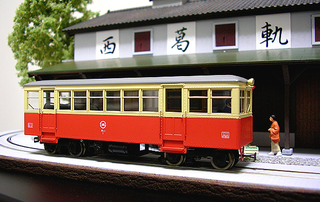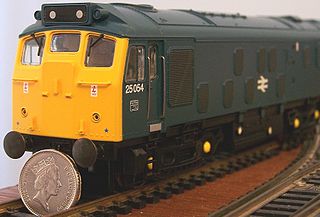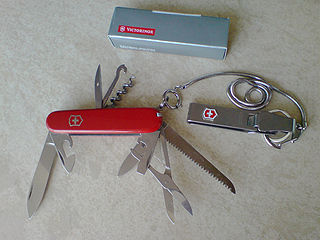
Railway modelling or model railroading is a hobby in which rail transport systems are modelled at a reduced scale.

OO gauge or OO scale is the most popular standard gauge model railway standard in the United Kingdom, outside of which it is virtually unknown. OO gauge is one of several 4 mm-scale standards, and the only one to be marketed by major manufacturers. The OO track gauge of 16.5 mm corresponds to prototypical gauge of 4 ft 1+1⁄2 in, rather than 4 ft 8+1⁄2 in standard gauge. However, since the 1960s, other gauges in the same scale have arisen—18.2 mm (EM) and 18.83 mm (Scalefour)—to reflect the desire of some modellers for greater scale accuracy.

A scale model is a physical model which is geometrically similar to an object. Scale models are generally smaller than large prototypes such as vehicles, buildings, or people; but may be larger than small prototypes such as anatomical structures or subatomic particles. Models built to the same scale as the prototype are called mockups.

The Swiss Army knife is a pocketknife, generally multi-tooled, now manufactured by Victorinox. The term "Swiss Army knife" was coined by American soldiers after World War II after they had trouble pronouncing the German word "Offiziersmesser", meaning "officer’s knife".

O scale is a scale commonly used for toy trains and rail transport modelling. Introduced by German toy manufacturer Märklin around 1900, by the 1930s three-rail alternating current O gauge was the most common model railroad scale in the United States and remained so until the early 1960s. In Europe, its popularity declined before World War II due to the introduction of smaller scales.

N scale is a popular model railway scale. Depending upon the manufacturer, the scale ranges from 1:148 to 1:160. Effectively the scale is 1:159, 9 mm to 1,435 mm, which is the width of standard gauge railway. However the scale may vary to simulate wide or narrow gauge rail. In all cases, the gauge is 9 mm or 0.354 in. The term N gauge refers to the track dimensions, but in the United Kingdom in particular British N gauge refers to a 1:148 scale with 1:160 track gauge modelling. The terms N scale and N gauge are often inaccurately used interchangeably, as scale is defined as ratio or proportion of the model, and gauge only as a distance between rails. The scale 1:148 defines the rail-to-rail gauge equal to 9 mm exactly, so when calculating the rail or track use 1:160 and for engines and car wheel base use 1:148.

Gebr. Märklin & Cie. GmbH or Märklin is a German toy company. The company was founded in 1859 and is based at Göppingen in Baden-Württemberg. Although it originally specialised in doll house accessories, today it is best known for model railways and technical toys. In some parts of Germany and in Sweden, the company's name is almost synonymous with model railways.
S scale is a model railroad scale modeled at 1:64 scale, S scale track gauge is 22.48 mm (0.885 in). S gauge trains are manufactured in both DC and AC powered varieties. S gauge is not to be confused with toy train standard gauge, a large-scale standard for toy trains in the early part of the 20th century.

TT scale is a model railroading scale at 1:120 scale with a Track gauge of 12 mm between the rails. It is placed between HO scale (1:87) and N scale (1:160). Its original purpose, as the name suggests, was to make a train set small enough to assemble and operate on a tabletop.

1 gauge, gauge 1 or gauge one is a model railway and toy train standard that was popular in the early 20th century, particularly with European manufacturers. Its track measures 1.75 in, making it larger than 0 gauge but slightly smaller than wide gauge, which came to be the dominant U.S. standard during the 1920s.
Bassett-Lowke was an English toy manufacturing company based in Northampton. Founded by Wenman Joseph Bassett-Lowke in 1898 or 1899, the company specialized in model railways, boats and ships, and construction sets. Bassett-Lowke started as a mail-order business, although it designed and manufactured some items.
Roco, based in Salzburg, Austria, is a manufacturer of model railway equipment.
HOn30 gauge is the modelling of narrow-gauge railways in HO on N gauge track in 1:87 scale ratio.
Lima S.p.A. is an Italian brand and former manufacturing company of model railways. The company was headquartered in Vicenza for almost 50 years, from the early 1950s until the company ceased trading in 2004. Lima was a popular, affordable brand of 00 gauge and N gauge model railway material in the UK, more detailed H0 and N gauge models in France, Germany, Italy, Switzerland, and the United States as well as South Africa, Scandinavia and Australia. Lima also produced a small range of 0 gauge models. Lima partnered with various distributors and manufacturers, selling under brands such as A.H.M., Model Power, and Minitrain. Market pressures from superior Far Eastern produce in the mid-1990s led to Lima merging with Rivarossi, Arnold, and Jouef. Ultimately, these consolidations failed and operations ceased in 2004.

On30gauge is the modelling of narrow gauge railways in O scale on HO gauge track in 1:48 scale ratio by American and Australian model railroaders, in 1:43.5 scale ratio by British and French model railroaders and 1:45 by Continental European model railroaders.

The H0m gauge is designed for the reproduction of narrow gauge railways with a prototype gauge of 850 to 1250 mm in H0 scale. The letter m stands for metre prototype gauge with a track width of 1000 mm. It runs on 12 mm TT scale tracks. Modern H0m trains run on realistic-looking two-rail track, which is powered by direct current, or by Digital Command Control. It is a popular scale in Europe, particularly for trains of Swiss outline.

McCormick-Stillman Railroad Park is a 30-acre (12 ha) railroad park located in Scottsdale, Arizona. It features a 15 in gauge railroad, a Magma Arizona Railroad locomotive, a railroad museum, three model railroad clubs and a 7+1⁄2 in gauge live steam railroad.

The Texas Transportation Museum (TTM) is a transportation museum located in San Antonio, Texas.

Egger-Bahn was a German model railway manufacturer. The company produced the first H0e models, and established HOe as a viable model railway standard. The firm was founded in 1963 by three brothers. One of them, a performer, soon left the firm. Theodor Egger, technician, and Jonathan Egger, salesman, continued. The models first appeared at the 1963 Nuremberg Toy Fair.

The EMD G22C Series were first introduced in 1968 to replace the popular G12 along with various improvements. They carried a low per axle weight on their Flexicoil Type-GC trucks and were the first model series to have a low nose as a standard option as well.